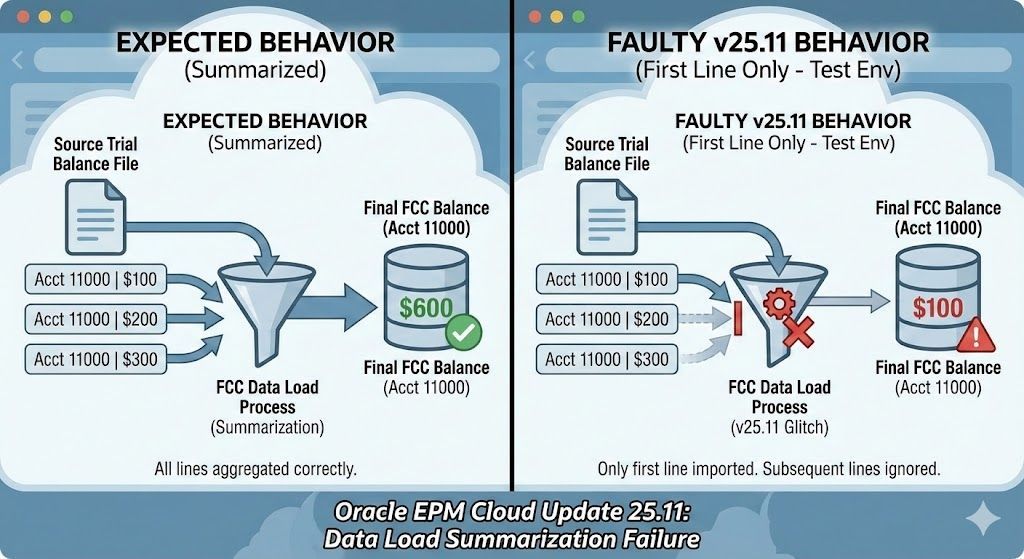Bridging the Gap: Exporting YTD Data from FCC to TRC for Seamless Tax Reporting
Nadia Lodroman | Oracle EPM Consultant | Integrity in Every Insight.
17 March 2025
Listen to Tresora and Ledgeron's chatting about this blog post:
Listen to the podcast below for a summary of this blog post:
Ensuring Accurate YTD Data in TRC: FCC Export Options Explained

Introduction:
Accurate and timely tax reporting is crucial for any organization. Oracle Financial Consolidation and Close (FCC) and Oracle Tax Reporting (TRC) are powerful tools that facilitate this process. However, effectively transferring Year-to-Date (YTD) data from FCC to TRC requires careful consideration of data transformation and export methods. In this post, we'll delve into two key approaches: leveraging FCC's Control To-Date View Storage and implementing explicit period mapping in TRC.
Understanding the Data Flow
Oracle FCC:
FCC is designed for financial consolidation, providing a comprehensive view of financial data, often in YTD format.
However, the way that YTD data is stored and retrieved can vary based on configuration.
Oracle TRC:
TRC focuses on tax reporting, requiring accurate and consistent data to calculate tax liabilities and prepare tax returns.
TRC also requires YTD data for many calculations.
Option 1: Leveraging FCC's Control To-Date View Storage
How it Works:
FCC offers a feature called "Control To-Date View Storage," which stores pre-calculated YTD balances. When enabled, FCC maintains a snapshot of YTD data, which can be directly exported to TRC. This removes the need to calculate the YTD inside of the TRC application.
Implications:
- Performance: Enabling Control To-Date View Storage can improve performance during data export, as the YTD calculations are already performed.
- Storage: This option increases storage requirements in FCC, as it stores additional YTD data.
- Data Integrity: Ensure that the Control To-Date View Storage is updated regularly to maintain data accuracy. If the storage is not updated after changes, then the data exported to TRC will be incorrect.
- Maintenance: Requires regular maintenance to ensure data consistency and accuracy.
- Flexibility: This method may limit flexibility if TRC requires specific YTD calculations that differ from the FCC's stored views.
Option 2: Explicit Period Mapping in TRC
How it Works:
This approach involves mapping FCC periods to TRC periods explicitly within TRC's data load settings. You can configure TRC to treat a specific prior period in FCC as the last day of the previous year. TRC then performs the YTD calculations based on the mapped periods.
This is very useful when FCC does not have the control to date view storage enabled, or when there is a need to manipulate the YTD calculations.
Implications:
- Flexibility: Provides greater flexibility in handling different YTD calculation requirements.
- Complexity: Requires careful configuration of period mappings to ensure accuracy.
- Performance: TRC performs the YTD calculations during data load, which may impact performance, especially for large datasets.
- Maintenance: Period mappings need to be reviewed and updated regularly, especially during changes to fiscal calendars.
- Data Validation: Requires thorough data validation to ensure that the YTD calculations are correct.
Choosing the Right Approach:
The optimal approach depends on your organization's specific needs and priorities. Consider the following factors:
- Data Volume: For large datasets, Control To-Date View Storage can improve performance.
- Calculation Complexity: If TRC requires complex YTD calculations, explicit period mapping might be preferable.
- Maintenance Effort: Control To-Date View Storage requires ongoing maintenance to ensure data accuracy.
- Flexibility: Explicit period mapping provides greater flexibility in handling different YTD requirements.
- IT Resources: The level of IT resources available to manage and maintain the integration.
Best Practices:
- Thoroughly test both approaches to evaluate performance and accuracy.
- Implement data validation checks to ensure data integrity.
- Document all period mappings and configuration settings.
- Establish a regular maintenance schedule to ensure data consistency.
- Work with the data owners of both FCC and TRC to ensure that the data is being transformed and loaded correctly.
Conclusion:
Exporting YTD data from FCC to TRC requires careful planning and execution. By understanding the implications of Control To-Date View Storage and explicit period mapping, organisations can choose the approach that best meets their needs. Accurate and timely data transfer is essential for effective tax reporting.
Seek guidance from Oracle experts to optimise your FCC and TRC integration.
Turning financial complexity into operational clarity. Because in Finance, Integrity is Permanent.






